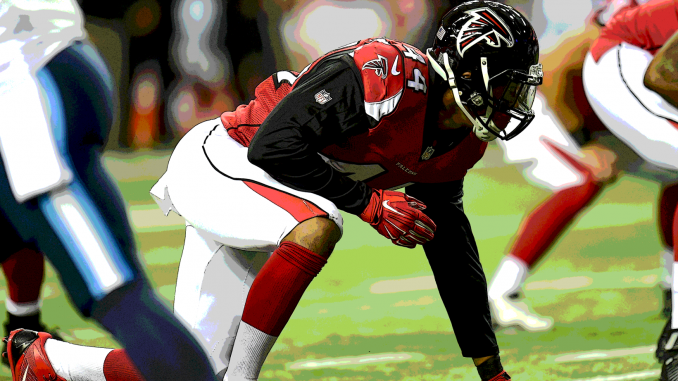
Force Players is an athletic threshold based off of combine performances of pass-rushers that I’ve been working on since 2011. It isn’t the end all be all for edge defenders, but it’s close. It works as a healthy risk analysis, based on a sample of the 2005 through 2015 draft classes.
I began a study to try to test if those who lack Force Player athleticism at 21 years old, like Joey Bosa, have a significantly higher “hit” rate than those who failed to reach the threshold at 22 or 23, and the results were inconclusive. What I was able to stumble into, though, was that you can tell how good a pass-rusher is going to be based on what their highest single-sack mark is at the age of 23 and what their athletic background is.
Sample set:
- 2005-2015 first- through third-round picks
- Force Players, Mid Tiers and non-Force Players
- Peak Average: best three sack totals averaged from Force Players: Sack Study
What was interesting to me is that Force Players, Mid Tiers and non-Force Players seem to have three different thresholds. For the purpose of simplifying an idea into one word, we’ll call those who pass the thresholds “Prodigies.” It was the first Google result for “What’s the opposite of a late-bloomer?”
- Force Players: 4 sacks
- Mid Tiers: 5.5 sacks
- non-Force Players: 7 sacks
This study was done by judging players’ age by how old they were on September 1 of a given year.
So, if a Force Player had four or more sacks during a season in which he began Week 1 as a 23-year-old or younger, then he passes. The same can be said of a Mid Tier with 5.5 sacks or a non-Force Player with seven sacks. Simple?
Here are the results by athletic category.
Force Players:
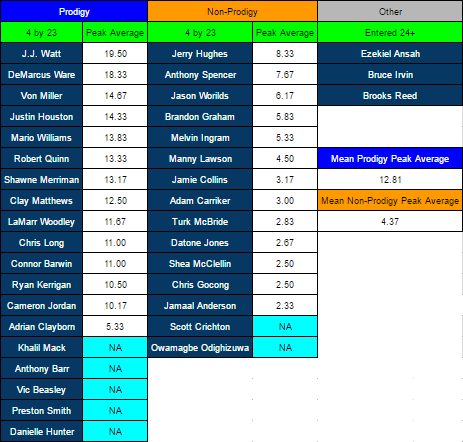
Mid Tiers:
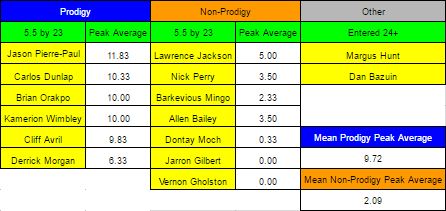
non-Force Players:
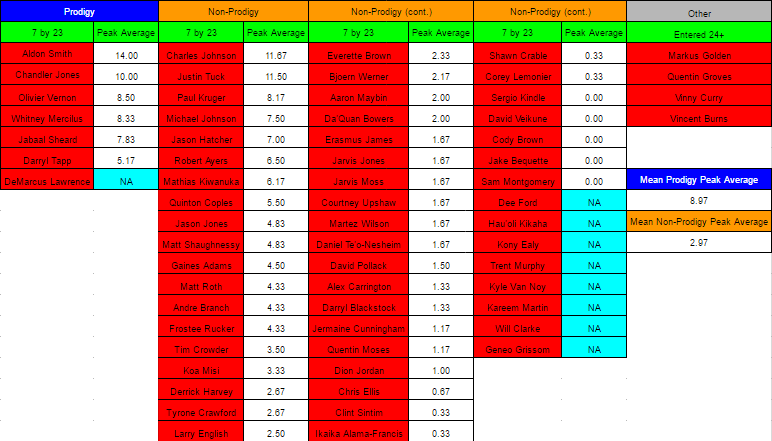
Here’s a visualization of every category combined, with the Prodigies highlighted in blue and the non-Prodigies highlighted in orange:
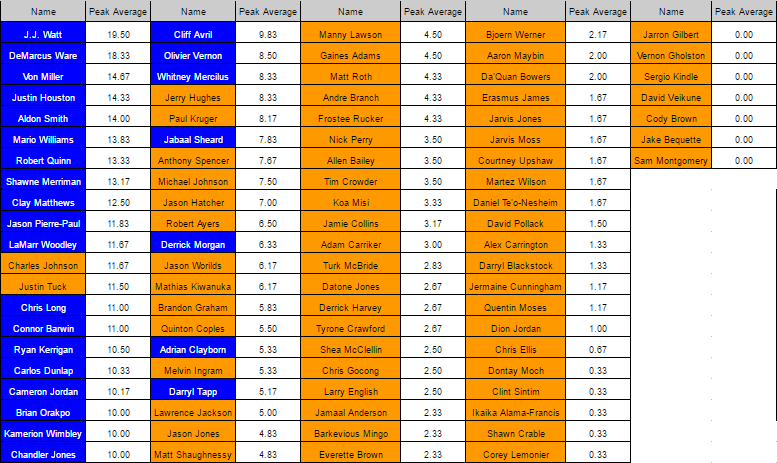
Notes on this:
- Charles Johnson and Justin Tuck had breakout season at 24 years old, but Tuck missed double-digit games in the season he began as a 23-year-old.
- Some of the top non-Prodigies were late-blooming Force Players like Jerry Hughes, Anthony Spence, Jason Worilds and Melvin Ingram.
- Paul Kruger was able to put together two nice seasons, with one coming off the bench in Baltimore. Michael Johnson, Jason Hatcher, and Robert Ayers, the three non-Force Player non-Prodigies following him, are largely products of one splash season among average careers.
- Adrian Clayborn (5.33) is the only Force Player Prodigy to net fewer than a 10.17 Peak Average. He missed the majority of his second and fourth seasons in the league due to injury after his 7.5-sack rookie season.
So what does this mean?
- It doesn’t look good for prospects who come into the league as 24-year-olds. We should already have a sample of how good they are, and the fact that they were still playing in college as 23-year-olds is concerning.
- For rookies who will start their careers at 23 years old, we should know right away if they will or won’t make an impact at the next level.
- We can say that there’s a fairly definitive line for success for pass-rushers who are X athletic with X production at X age.
The following table is a list of players who either just completed the season at 23 years old or have already passed through the filter at a younger age, but all have spent less than three seasons in the league. On the far right is the projected sum of a pass-rusher’s top three seasons, based on Prodigy status and athletic category. It’s simply the Mean Peak Average of similar edge defenders multiplied by three and rounded.
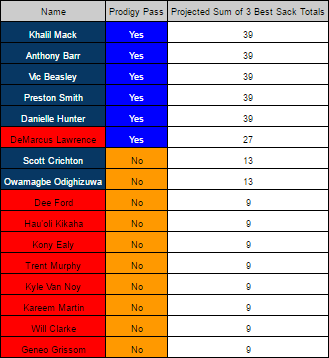
Numbers would suggest to buy stock in Vic Beasley, despite the backlash on him, and DeMarcus Lawrence, despite his athletic background. Preston Smith and Danielle Hunter led rookies in sacks off of the bench last season, and in a weak pass-rushing draft class, teams would be smart to see about potentially trading for one of them.
Here are the edge defenders who have yet to play a season at 23 years old, and have yet to hit the threshold set by Prodigy.
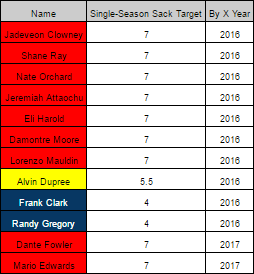
For all but Dante Fowler and Mario Edwards, who entered the league as 21-year-olds last season, 2016 will be a make or break season for the group.
Here’s a look at the 2016 draft class. FRX is essentially the over-under of when a player will be drafted based off of the current numbers on Play the Draft, which I find to be a decent measure of draft stock. These are the first- through third-round “DE” prospects on their site, along with some other players I believe can be edge rushers.
Age is based on how old a player will be on September 1 of this year, but it should be noted that Leonard Floyd will turn 24 on September 8, the very day the NFL season kicks off. He’s beginning his professional career as a 24-year-old. Ages came from Dane Brugler’s 2016 Draft Guide, which is well worth the $6.99 you can buy it for. It has been my go-to guide for the past three or four years.
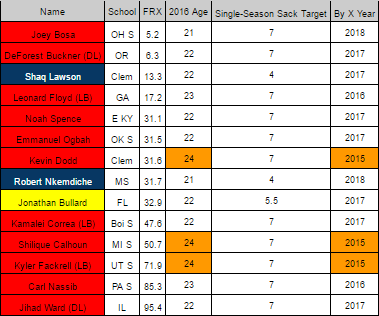
So, in terms of make or break seasons, the fates of Floyd (a very old 23) and Carl Nassib should be sealed by the end of their rookie campaigns.
Justis Mosqueda
Latest posts by Justis Mosqueda (see all)
- Force Players: League-Wide Update - May 1, 2016
- 2016 Packers Draft Tweets - April 29, 2016
- 2016 First-Round Pass-Rushers - April 29, 2016
